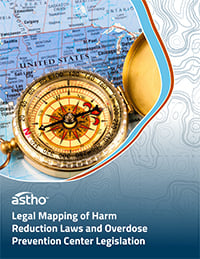Legal Mapping of Harm Reduction Laws and Overdose Prevention Center Legislation
July 31, 2023
 CDC data highlights a staggering number of nearly 110,000 drug overdose deaths in 2022. Potent synthetic opioids such as fentanyl have added to the rising number of overdose deaths and other substances such as xylazine have called for adjusted protocols when responding to an overdose, prompting state and territorial health agencies (S/THAs) to respond and mitigate overdose-related harms through robust prevention and surveillance efforts.
CDC data highlights a staggering number of nearly 110,000 drug overdose deaths in 2022. Potent synthetic opioids such as fentanyl have added to the rising number of overdose deaths and other substances such as xylazine have called for adjusted protocols when responding to an overdose, prompting state and territorial health agencies (S/THAs) to respond and mitigate overdose-related harms through robust prevention and surveillance efforts.
Reducing overdose deaths requires layered intervention strategies to ensure that people who use drugs receive resources that prevent overdose and that support access to treatment. Several evidence-based and promising interventions—including community-wide distribution of naloxone, fentanyl test strip distribution, and the adoption of overdose prevention centers—intended to minimize the negative consequences of drug use (i.e., harm reduction). These strategies are also effective at preventing the spread of infectious disease, connecting people who use drugs to substance use disorder treatment, and preventing overdoses.
ASTHO, with support from CDC’s Overdose Data to Action (OD2A) cooperative agreement, developed an interactive resource visualizing state and territorial laws that support harm reduction activities as of January 1, 2023. This report highlights the public health importance of three harm reduction policies and practices to reduce overdoses:
- Facilitating community distribution of naloxone.
- Facilitating community distribution of fentanyl test strips (FTS).
- Overdose prevention centers.